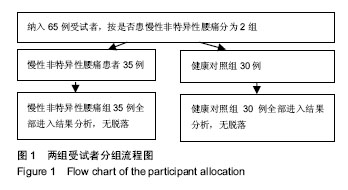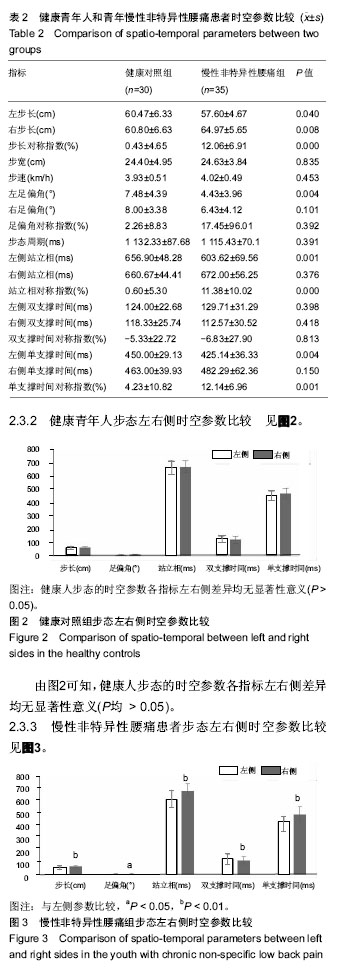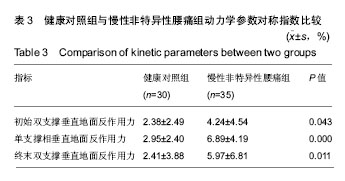| [1] Wand BM, O'Connell NE. Chronic non-specific low back pain-sub-groups or a single mechanism? BMC Musculoskelet Disord. 2008;9:11. [2] Hoy D, Brooks P, Blyth F, et al. The epidemiology of low back pain. Best Pract Res Clin Rheumatol. 2010;24(6):769-781. [3] Machado GC, Maher CG, Ferreira PH, et al. Can Recurrence After an Acute Episode of Low Back Pain Be Predicted? Phys Ther. 2017;97(9):889-895. [4] 戴胡明,方诗元.步态分析在脊柱疾病中的研究现状[J].安徽医学, 2013,34(4):514-517.[5] 牟鑫,张国辉,张宏,等.慢性腰痛患者步态规律的研究[J].当代医学,2018,24(3):29-32.[6] Monticone M, Ambrosini E, Rocca B, et al. A multidisciplinary rehabilitation programme improves disability, kinesiophobia and walking ability in subjects with chronic low back pain: results of a randomised controlled pilot study. Eur Spine J. 2014;23(10):2105-2113. [7] Gordon R, Bloxham S. A systematic review of the effects of exercise and physical activity on non-specific chronic low back pain. Healthcare (Basel). 2016;4(2). pii: E22. [8] Hendrick P, Wake AMT, Tikkisetty AS, et al. The effectiveness of walking as an intervention for low back pain: a systematic review. Eur Spine J. 2010;19(10):1613-1620. [9] Hendrick P, Milosavljevic S, Hale L, et al. The relationship between physical activity and low back pain outcomes: a systematic review of observational studies. Eur Spine J. 2011;20(3):464-474. [10] Zahraee MH, Karimi MT, Mostamand J, et al. Analysis of asymmetry of the forces applied on the lower limb in subjects with nonspecific chronic low back pain. Biomed Res Int. 2014; 2014:289491. [11] Burnett DR, Campbell-Kyureghyan NH, Cerrito PB, et al. Symmetry of ground reaction forces and muscle activity in asymptomatic subjects during walking, sit-to-stand, and stand-to-sit tasks. J Electromyogr Kinesiol. 2011;21(4): 610-615. [12] Sadeghisani M, Sobhani V, Kabir MM, et al. Investigation of weight-bearing symmetry in a group of athletes with low back pain and healthy people during gait. J Mech Med Biol. 2017. [13] Griffin DW, Harmon DC, Kennedy NM. Do patients with chronic low back pain have an altered level and/or pattern of physical activity compared to healthy individuals? A systematic review of the literature. Physiotherapy. 2012; 98(1):13-23. [14] 黄萍,钟慧敏,陈博,等.正常青年人三维步态:时空及运动学和运动力学参数分析[J].中国组织工程研究,2015,19(24): 3882-3888.[15] 赵滢,陆阿明.不同步行和跑步速度对后足角度和足偏角的影响[J].体育科研,2017,38(6):93-100.[16] 顾琳燕,邱华平,张晟宇,等.正常人群步行足偏角与年龄特征分析[J].生物医学工程学杂志,2018;35(1):45-48.[17] Sung PS, Danial P. A kinematic symmetry index of gait patterns between older adults with and without low back pain. Spine. 2017;42(23):E1350-E1356. [18] Sadeghi H, Allard P, Prince F, et al. Symmetry and limb dominance in able-bodied gait: a review. Gait Posture. 2000;12(1):34-45. [19] Sung PS, Danial P, Lee DC. Comparison of the different kinematic patterns during lateral bending between subjects with and without recurrent low back pain. Clin Biomech. 2016;38:50-55. [20] Lee CE, Simmonds MJ, Etnyre BR, et al. Influence of pain distribution on gait characteristics in patients with low back pain: part 1: vertical ground reaction force. Spine (Phila Pa 1976). 2007;32(12):; 1329-1336. [21] O'Leary CB, Cahill CR, Robinson AW, et al. A systematic review: The effects of podiatrical deviations on nonspecific chronic low back pain. J Back Musculoskelet Rehabil. 2013; 26(2):117-123. [22] Zafereo J, Devanna R, Mulliga E, et al. Hip Stiffness Patterns in Lumbar Flexion- or Extension-Based Movement Syndromes. Arch Phys Med Rehabil. 2015;96(2):292-297. [23] Pakzad M, Fung J, Preuss R. Pain catastrophizing and trunk muscle activation during walking in patients with chronic low back pain. Gait Posture. 2016;49:73-77. [24] Steele J, Bruce-Low S, Smith D, et al. A randomized controlled trial of the effects of isolated lumbar extension exercise on lumbar kinematic pattern variability during gait in chronic low back pain. PM R. 2016;8(2):105-114. [25] Fasano A, Bloem BR. Gait disorders. Continuum (Minneap Minn). 2013;19(5 Movement Disorders):1344-1382. [26] Diamond S, Borenstein D. Chronic low back pain in a working-age adult. Best Pract Res Clin Rheumatol. 2006; 20(4):707-720. [27] Campbell A, Straker L, O'Sullivan P, et al. Lumbar loading in the elite adolescent tennis serve: link to low back pain. Med Sci Sports Exerc. 2013;45(8):1562-1568. [28] Cole MH, Grimshaw PN. The crunch factor's role in golf-related low back pain. Spine J. 2014;14(5):799-807. [29] Grosdent S, Demoulin C, Souchet M, et al. Trunk muscle profile in elite tennis players with and without low back pain. J Sports Med Phys Fitness. 2015;55(11):1354-1362. [30] Sadeghisani M, Shaterzadeh MJ, Karimi MT, et al. Kinematic differences in lumbopelvic and hip movement patterns during a lower limb movement test between two groups of people with low back pain. J Mechan Med Biol. 2017. [31] Cibulka MT, Strube MJ, Meier D, et al. Symmetrical and asymmetrical hip rotation and its relationship to hip rotator muscle strength. Clin Biomech. 2010;25(1):56-62. [32] Swain C, Redding E. Trunk muscle endurance and low back pain in female dance students. J Dance Med Sci. 2014;18(2): 62-66. [33] LaRoche DP, Cook SB, Mackala K. Strength Asymmetry Increases Gait Asymmetry and Variability in Older Women. Med Sci Sports Exerc. 2012;44(11):2172-2181. [34] Stacoff A, Diezi C, Luder G, et al. Ground reaction forces on stairs: effects of stair inclination and age. Gait Posture. 2005; 21(1):24-38. [35] Bautmans I, Jansen B, Van Keymolen B, et al. Reliability and clinical correlates of 3D-accelerometry based gait analysis outcomes according to age and fall-risk. Gait Posture. 2011; 33(3):366-372. [36] Tsao H, Hodges PW. Immediate changes in feedforward postural adjustments following voluntary motor training. Exp Brain Res. 2007;181(4):537-546. [37] Zahraee MH, Karimi MT, Mostamand J, et al. Analysis of asymmetry of the forces applied on the lower limb in subjects with nonspecific chronic low back pain. Biomed Res Int. 2014;2014:289491. [38] Roffey DM, Wai EK, Bishop P, et al. Causal assessment of occupational standing or walking and low back pain: results of a systematic review. Spine J. 2010;10(3):262-272. |
.jpg)



.jpg)
.jpg)